| |
|
Spain led the Holy League to Defeat
the Muslim Ottoman Turkish Navy
*The Battle of Lepanto in 1571* |
|
Spain saved Western Civilization
from being overrun by Islam through Defeating the Ottoman Navy |
|
Rather than following on this Victory and Freeing
the Rest of the Mediterranean from Muslim Control
Spain sent its Invincible Spanish Armada on MAY 19th, 1588 to Conquer
England |
When Queen Mary I died, and with her Englandís brief and bloody
restoration of Catholicism, she was replaced with Elizabeth I, who
re-imposed Protestantism. Elizabeth was daughter of King Henry VIII and
Anne Boleyn.
Philip II of Spain, Maryís widower, didnít take too kindly to this
outrageous heresy. So he built a vast fleet of ships, and assembled an
army of 30,000 men in the Netherlands. The two would join up and after a
swift and efficient invasion, England would be restored to the Catholic
fold. |
|
Queen Anne Boleyn |
Queen Mary I |
Queen Elizabeth I |
|
Above Right - Portrait of Queen Elizabeth painted
soon after the defeat of the "Invincible" Armada.
In the left background can be seen the English fleet and the Spanish
Armada is on the rocks to the right. |
| After the accession of Elizabeth I in 1558, Protestant England was
beset by the hostile Catholic powers of Europe, including Spain. In
October 1585, King Philip II of Spain declared his intention to destroy
Protestant England and began preparing invasion plans, leading to an
intense intelligence war between the two countries and culminating in
the dramatic sea battles of 1588. In the latter part of the 16th
century, Spain was the major international power and either ruled,
colonized, or exercised influence over much of the known world. English
'Sea Dogs' had been causing a great deal of damage to Spain's trade in
silver. Men such as Sir Francis Drake attacked Spanish shipping off of
the West Indies and Spain lost a vast sum of money when the ships
carrying silver sunk or had their cargo captured by Drake. To the
English, Drake was a hero but to the Spanish he was nothing more than a
pirate who, in their view, was allowed to do what he did with the full
knowledge of Queen Elizabeth. This the Spanish could not accept. |
|
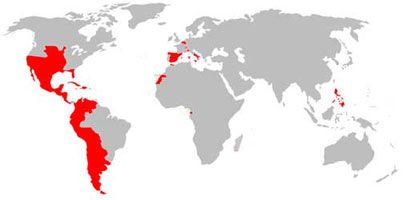 |
|
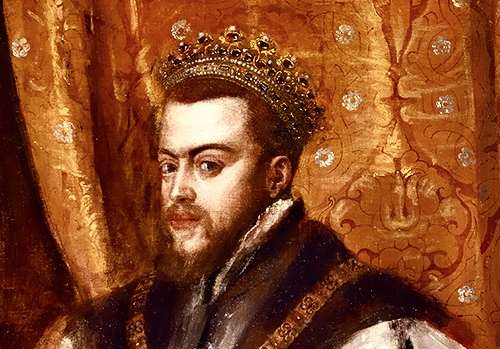 |
|
Spanish Empire of Phillipe II |
King Philip II of Spain |
| Philip II was the sole ruler of this vast domain. He was the
most bigoted fanatic that ever counted beads or crossed himself before a
crucifix. It was said that the only time he ever laughed was when he
heard the report of the infamous St. Bartholomew's Day massacre of
100,000 Protestant Christians in France. The Duke of Medina Sidonia
was given command of the Spanish Armada. The Spanish Armada ships were
filled with fanatical Jesuits, and racks, pulleys, thumbscrews, iron
virgins, gridirons and other diabolical instruments of torture to be
used once the Spanish Inquisition was set up in England. Consisting of
130 ships with 1,500 brass guns and 1,000 iron guns, carrying 8,000
sailors and 18,000 soldiers, they were planning on picking up 30,000
more soldiers from the Spanish Netherlands. |
|
Charles Howard - Lord High Admiral
2nd Baron of Effingham, Earl of Nottingham (1536-1624) |
Sir Francis Drake
Called - El Draque "the Dragon" by the Spanish
Inquisition |
| In 1585, Lord Charles Howard was appointed Lord High Admiral of
England, despite having only limited experience at sea. Thus he was in
command of the Royal Navy when the Spanish Armada sailed to attack
Britain in 1588. Sir Francis Drake was appointed vice admiral of the
English Navy, under Howard.
Queen Elizabeth relied on Sir Francis Drake, Sir John Hawkins, and
Sir Martin Frobisher, whose smaller, faster vessels were able to elude
the enormous Spanish galleons. Elizabeth had also appointed Lord Howard
of Effingham to command the English fleet, a leader considered strong
enough to keep Drake, Hawkins and Frobisher under control. |
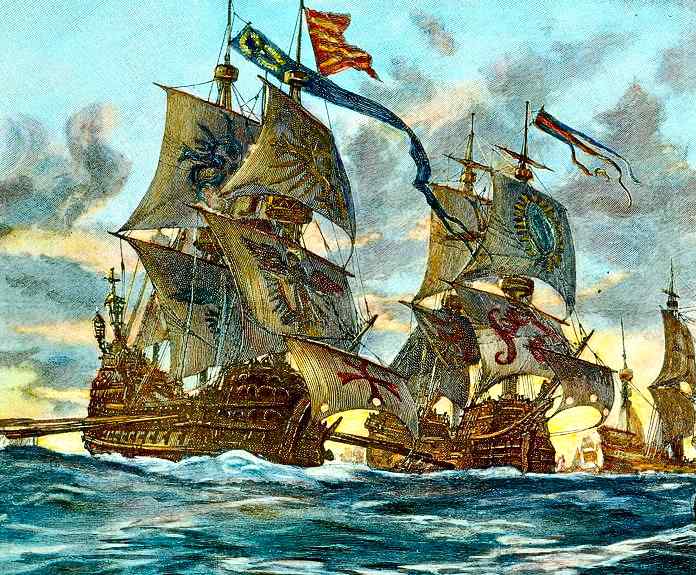 |
On July 21st, 1588, 130 ships of the Spanish Armada entered the
English Channel in a crescent formation. The English fleet sailed out to
meet them.
For several days, the English fleet used its superior speed and
maneuverability to harass the Armada with long-range cannon fire.
Spanish ships were damaged and Drake was able to capture one of the
Spanish ships carrying the payroll for the Spanish Army. This battle was
decided by the superior speed and maneuverability of the long, low
English ships and by their long range firepower.
The Spanish were accustomed to the Mediterranean style of naval
fighting, which called for ramming and boarding. Instead, the English
raked the Spaniards with broadsides at long range.
The Duke of Medina Sidonia was forced to wait for tardy infantry at
an exposed anchorage. Captain Drake sent fire ships sailing pell-mell towards the exposed
flank of the Spanish Navy. Desperate Armada captains cut away their
anchor cables in a panic to escape. In the melee that followed the
Spanish squadrons became confused. All the super galleons managed to
dodge the fire ships by fleeing into the deep waters of the English
Channel. But there were many collisions of the monstrous warships in the
night, leaving crews demoralized and exhausted. |
| As soon as the Armada galleons left the sanctuary of the shore, they
were caught in a strong offshore breeze that carried them helplessly
towards the North Sea. The Armada galleons were swept relentlessly into
the North Atlantic Ocean.
Medina Sidonia was forced to take the Armada north around Scotland
and back to Spain. The despairing crews were hammered by gale force
winds as they tried to sail south along the Irish Coast. Most of the
ships and sailors were lost on that perilous voyage, smashed helplessly
against the Irish coastal rocks.
The ships that survived the storm headed for what should have been a
friendly Catholic Ireland in order to re-supply for their journey home
to Spain. Taking shelter in what is now called Armada Bay, just south of
Galway, the starving Spanish sailors went ashore to experience that
famous Irish hospitality. Hospitality was apparently short and swift,
with all who went ashore attacked and killed.
So, the great fleet sent by Philip II of Spain against England in 1588
was defeated in the Channel by the English fleets and almost completely
destroyed by storms. When the tattered Armada eventually returned to
Spain, it had lost half its ships and threequarters of its men. Over
20,000 Spanish sailors and soldiers had been killed, the vast majority
victims not of English cannon fire, but of lack of food and water,
virulent disease and incompetent organization. On the other side the
English lost no ships and only 100 men in battle. |
|
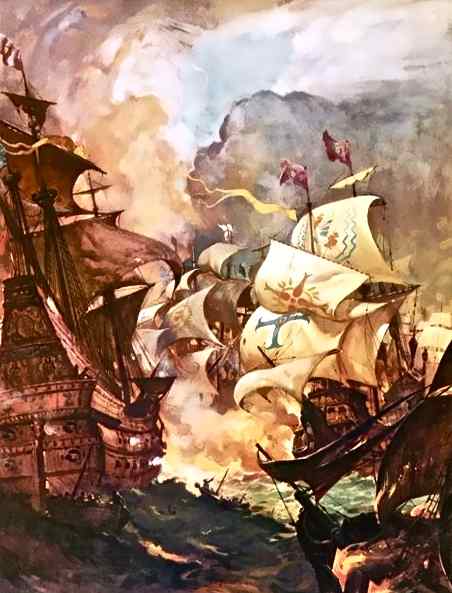 |
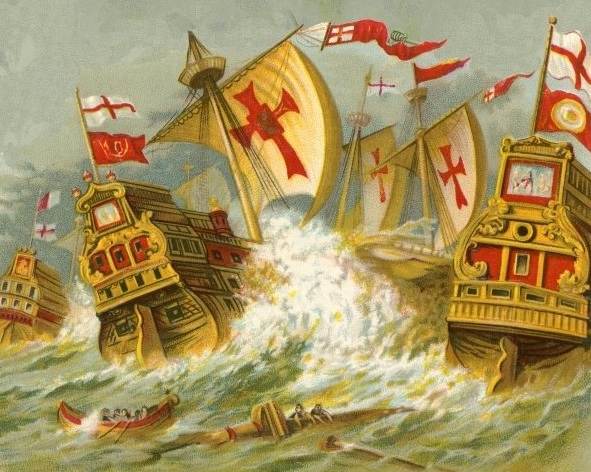 |
The sinking of the Spanish Armada broke Spainís monopoly on the New
World, held since the time of Columbus, and opened up a rush of European
countries staking their claim in North America. Had England lost, there
would have been no Pilgrims, no New England, and no United States of
America. In the course of the 17th centuryÖ English, French, Dutch,
Danes, and Swedes attempted to make some settlements in the new world.
The victory was a huge boon for Elizabeth, England and the Protestant
faith, and dealt a massive blow to Spainís dreams of world domination.
The victory over the Armada was greeted throughout England as divine
approval for the Protestant cause and the storms that ravaged the Armada
as 'Divine Intervention by God'. |
|
There was no real navy in the modern sense. The fleet
which chased the Spaniards up the Channel was a volunteer fleet.
Merchants had learned to defend their own cargoes. They built fighting
craft of their own to keep their coasts and harbors free of pirates, and
to carry their goods over sea. They sought their fortunes as they
pleased abroad, the crown annoying them with no inquiry to embarrass
their search for Spanish treasure ships, or their trade in pirated
linens and silks.
An English census in 1588 revealed only one hundred
experienced ďmartial menĒ were available for military service and, as
some had fought in Henry VIIIís French and Scottish wars of forty years
before, these old sweats were considered hors dí combat. Infantry and
cavalry were drawn from the trained bands and county militia. One
thousand unpaid veterans from the English army in the Netherlands were
hurriedly recalled but they soon deserted to hide in the tenements of
Kentís Cinque Ports.
Despite strenuous efforts to buy weapons in Germany and
Arquebuses from Holland, many militiamen were armed only with bows and
arrows. A large proportion was unarmed and untrained.
When the Armada eventually cleared Cornwall, some of the
Cornish militia, ordered to reinforce neighboring counties, thought they
had done more than enough to serve Queen and country. Their minds were
on the harvest and these reluctant soldiers decided to slink away from
their commanders and their colors.
Sir Francis Drake contracted dysentery on January
28th, 1596, and died of fever. He was buried in a lead coffin at sea
near Portobello, Panama. Divers continue to search for the coffin to
this day. |
|
 |
|
Spanish Armada Cannons
Dating to 1588 - Discovered off Ireland |
|
Cannons and Other Relics from a
Vessel that was part of the Spanish Armada Discovered |
At least five large guns, dating to 1588, were found along the sandy
bottom off Streedagh, in Sligo. The weapons were said to be in excellent
condition, despite spending more than 400 years on the sea floor. Two of
the cannons have been recovered so far.
They have uncovered a wealth of fascinating and highly significant
material, which is more than 425 years old. The material is obviously
very historically and archaeologically significant. |
The discovery was made off Streedagh, along a remote stretch of
coastline, in North Sligo.
Powerful winter storms are believed responsible for uncovering the
weapons, and for delivering parts of the wreckage to the shore,
prompting the archaeological expedition. |
The ship, which was built in 1570 was, sank along with two other
Armada vessels during ferocious storms in 1588, killing more than 1,000
soldiers and sailors.
La Julianaís trade route included Spain and Italy, before the ship was
commandeered by King Philip II to become part of the Armada fleet
outfitted to invade England. |
|
Last Raider Reunion |
Now Only Four Survive |
The Doolittle Raid of April 18, 1942 was the first U.S. air raid to
strike the Japanese home islands during WWII. The mission is notable in
that it was the only operation in which U.S. Army Air Forces bombers
were launched from an aircraft carrier into combat. The raid
demonstrated how vulnerable the Japanese home islands were to air attack
just 4 months after their surprise attack on Pearl Harbor. Launched from
the aircraft carrier Hornet and led by Lieutenant Colonel James H.
Doolittle, it was the most daring operation yet undertaken by the United
States in the young Pacific War.
After Japan's attack on Pearl Harbor, with the United States reeling
and wounded, something dramatic was needed to turn the war effort
around. There were no friendly airfields close enough to Japan for
the United States to launch a retaliation. The raid had its roots in a
chance observation that it was possible to launch Army twin-engined
bombers from an aircraft carrier, making feasible an early air attack on
Japan. Appraised of the idea in January 1942, U.S. Fleet commander
Admiral Ernest J. King and Air Forces leader General Henry H. Arnold
greeted it with enthusiasm. Arnold assigned the technically-astute
Doolittle to organize and lead a suitable air group. The modern, but
relatively well-tested B-25B "Mitchell" medium bomber was selected as
the delivery vehicle and tests showed that it could fly off a carrier
with a useful bomb load and enough fuel to hit Japan and continue on to
airfields in China.Finally, on the day of the raid, the Japanese military caught wind of
the plan. The Raiders were told that they would have to take off from
much farther out in the Pacific Ocean than they had counted on. They
were told that because of this they would not have enough fuel to make
it to safety, but the Doolittle Raiders launched the attack. Squadron
Leader Lt. Col. James Doolittle himself flew the lead plane off the USS
Hornet.
Most of the sixteen B-25s, each with a five-man crew, attacked the Tokyo
area, with a few hitting Nagoya. Damage to the intended military targets
was modest, and none of the planes reached the Chinese airfields (though
all but a few of their crewmen survived). However, the Japanese high
command was deeply embarrassed. Spurred by Combined Fleet commander
Admiral Isoroku Yamamoto, they also resolved to eliminate the risk of
any more such raids by the early destruction of America's aircraft
carriers, a decision that led them to disaster at the Battle of Midway a
month and a half later. |
|
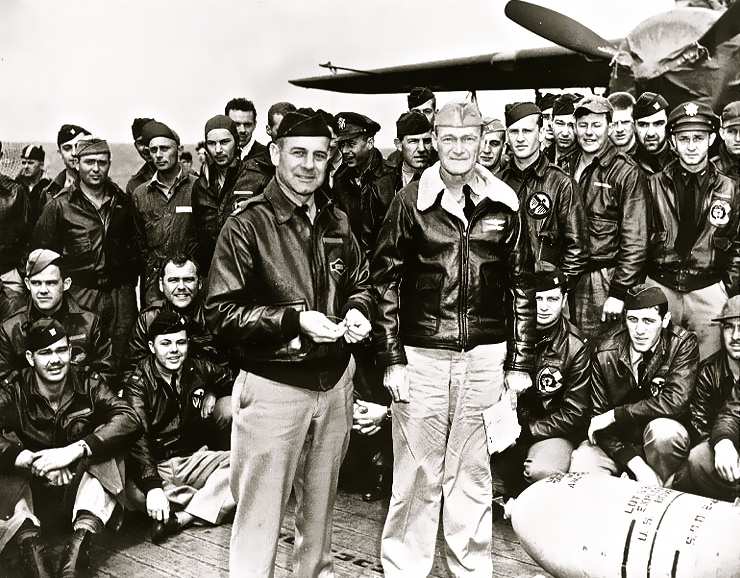 |
 |
After they bombed Tokyo they flew as far as they could. Four planes
crash-landed; 11 more crews bailed out, and three of the Raiders died.
Eight more were captured; three were executed. Another died of
starvation in a Japanese prison camp. One crew made it to Russia.
Another, after bailing out of his plane over a mountainous Chinese
forest after the Tokyo raid, became ill with malaria, and almost
died. When he recovered, he was sent to Europe to fly more combat
missions. He was shot down, captured, and spent 22 months in a German
prisoner of war camp.
Of the 80 Raiders, 62 survived the war. They were celebrated as national
heroes, models of bravery. Metro-Goldwyn-Mayer produced a motion picture
based on the raid;
"Thirty Seconds Over Tokyo", starring Spencer Tracy
and Van Johnson, was a patriotic and emotional box-office hit, and the
phrase became part of the national lexicon. In the movie-theater
previews for the film, MGM proclaimed that it was presenting the story
"with supreme pride." |
|
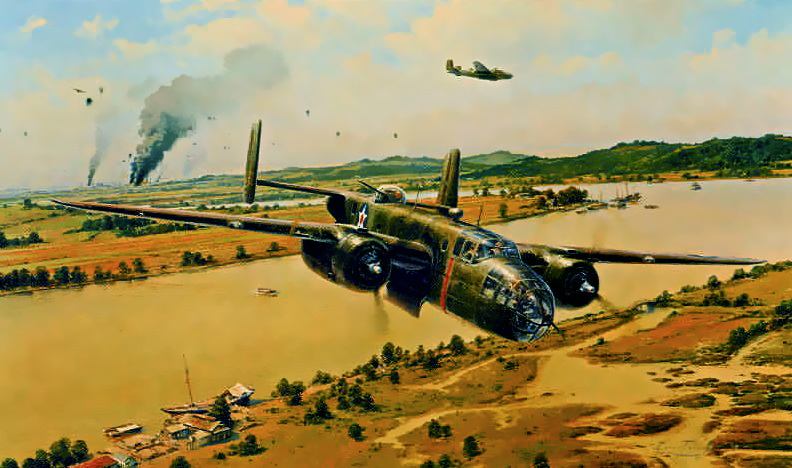 |
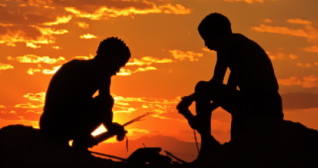 |
 |
Warfare was uncommon among hunter-gatherers, and killings among
nomadic groups were often due to competition for women or interpersonal
disputes, researchers in Finland said.
Their study in the US journal Science suggests that the origins of war
were not -- as some have argued -- rooted in roving hunter-gather groups
but rather in cultures that held land and livestock and knew how to farm
for food. |
For clues on what life was like before colonial powers, missionaries
and traders entered the scene, anthropologists examined a subset of
records from a well-known database that contains information on 186
cultures around the world.
"To be purists, we took only the oldest high-quality sources for each
culture," Fry told the journal Science, adding that these studies would
best showcase the people's traditional ways.
The groups included the Montagnais people of Canada, the Andamanese
people of India, the Botocudos of Brazil, and the !Kung people who live
in isolated areas of Botswana, Angola and Namibia.
These old records contained data on 148 lethal events. Of the 138
killings in which circumstances were "unambigious," 55 percent were
determined to have involved one killer and one victim, the study said.
In most killings (85 percent of the time), the killer and victim came
from the same society. Men were most often the killers. Women were the
aggressors just four percent of the time. "Most incidents of lethal
aggression can aptly be called homicides, a few others feud, and only a
minority warfare," said the study. |
 |
Reasons for the killings varied, with 11.5 percent stating revenge
as the motive, 9.5 percent saying it was over a particular woman, and
6.1 percent being cases when a husband killed his wife. Twenty-two
percent were linked to miscellaneous interpersonal disputes. Less common
motives included fights over resources such as a fruit tree (1.4
percent).
"In my view, the default for nomadic foragers is non warring," Fry told
Science. |
|
Libya 1911: The Genesis Of Aerial Bombardment
It
was in Libya, over a century ago, that a young Italian pilot
carried out the first ever air raid
Already in the late 19th
century some were becoming nervous that developments in balloon and dirigible
technology meant it was only a question of time before humans took warfare to
the skies. Delegates from various states met in The Hague in 1899 and signed a
declaration banning the militarization of the air.
|
 |
|
Lieutenant Guilo Cavotti
was a future oriented, risk taking, innovative Italian pilot. One day
he took off on his plane, equipped with a Danish "Hassen" hand grenade.
When he spotted the enemy he lobbed the grenade at them, to great
effect, and thereby introduced aerial warfare to human kind. The time
was over 100 years ago. The place was Libya. His exploits constituted an
opening salvo in Italyís 1911 attack on Libya. One hundred years later,
almost as if it is to mark the centenary with near poetic symmetry,
Italy is active once more as part of the coalition that is attacking
from the skies over Libya again. The Libyan theatre of 1911 was also the
place of the first aerial photo and the first ever night bombing raid. |
|
Military History Magazine
No aspect of world history can be more fascinating than
the study of the military and war. The articles in Military History will
help you learn more about this complex subject. Military History gives
insightful and intellectual perspectives into the intriguing world of
war. The strategies, the battles, the men who make the life and death
decisions are all dissected and discussed in this publication, for the
professional educator and the casual enthusiast. In every issue, you'll
explore the invasions and conflicts that shaped our world. Military
History brings the past to life. |
 |
|
